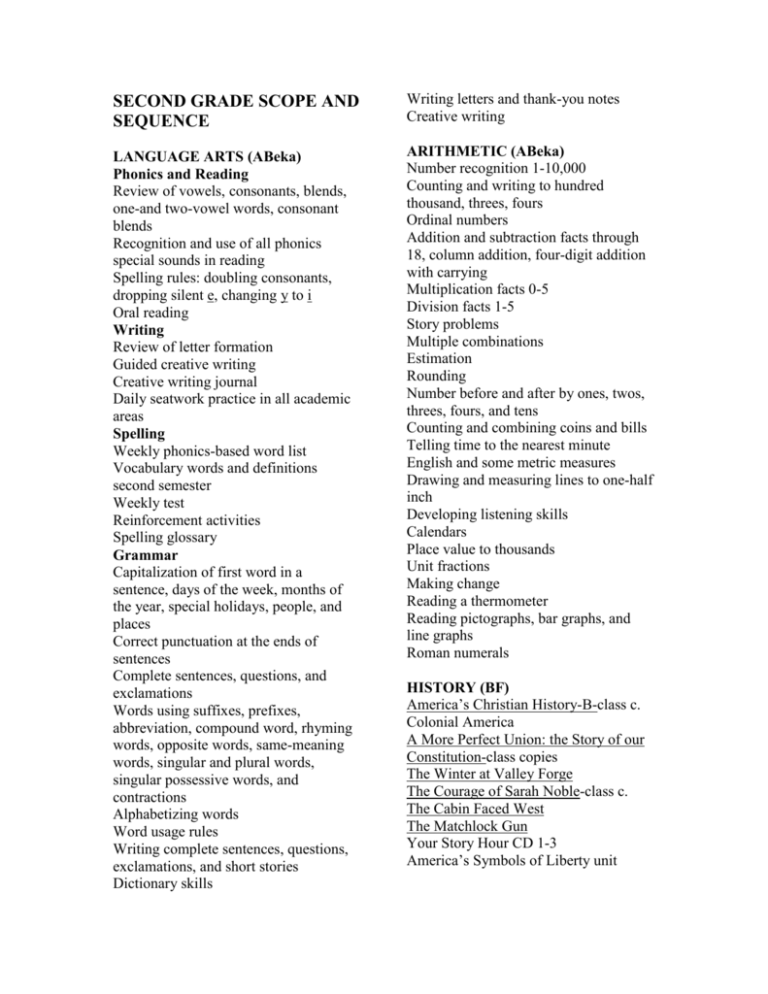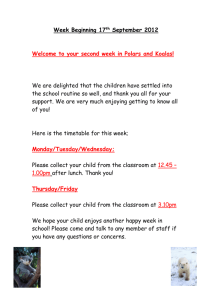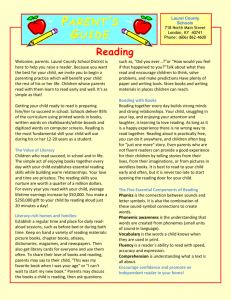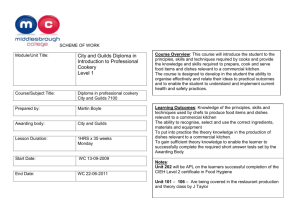2nd Grade - Castle Rock Christian – Love. Learn. Lead.
advertisement

SECOND GRADE SCOPE AND SEQUENCE Writing letters and thank-you notes Creative writing LANGUAGE ARTS (ABeka) Phonics and Reading Review of vowels, consonants, blends, one-and two-vowel words, consonant blends Recognition and use of all phonics special sounds in reading Spelling rules: doubling consonants, dropping silent e, changing y to i Oral reading Writing Review of letter formation Guided creative writing Creative writing journal Daily seatwork practice in all academic areas Spelling Weekly phonics-based word list Vocabulary words and definitions second semester Weekly test Reinforcement activities Spelling glossary Grammar Capitalization of first word in a sentence, days of the week, months of the year, special holidays, people, and places Correct punctuation at the ends of sentences Complete sentences, questions, and exclamations Words using suffixes, prefixes, abbreviation, compound word, rhyming words, opposite words, same-meaning words, singular and plural words, singular possessive words, and contractions Alphabetizing words Word usage rules Writing complete sentences, questions, exclamations, and short stories Dictionary skills ARITHMETIC (ABeka) Number recognition 1-10,000 Counting and writing to hundred thousand, threes, fours Ordinal numbers Addition and subtraction facts through 18, column addition, four-digit addition with carrying Multiplication facts 0-5 Division facts 1-5 Story problems Multiple combinations Estimation Rounding Number before and after by ones, twos, threes, fours, and tens Counting and combining coins and bills Telling time to the nearest minute English and some metric measures Drawing and measuring lines to one-half inch Developing listening skills Calendars Place value to thousands Unit fractions Making change Reading a thermometer Reading pictographs, bar graphs, and line graphs Roman numerals HISTORY (BF) America’s Christian History-B-class c. Colonial America A More Perfect Union: the Story of our Constitution-class copies The Winter at Valley Forge The Courage of Sarah Noble-class c. The Cabin Faced West The Matchlock Gun Your Story Hour CD 1-3 America’s Symbols of Liberty unit LITERATURE (FACE) Literature of the Bible-Psalm1 Poetry-Hiawatha Children’s Classic-Heidi Benjamin West and His Cat Shakespeare-Comedy of Errors SCIENCE (ABeka) Plants Enjoying the Plant World Animals Enjoying the Animal World Health and Human Biology Enjoying Myself and Others Earth and Space Enjoying our Earth and Sky Matter Enjoying the Air Around Us Energy Enjoying the Air Around Us Enjoying Things That Move Conservation Enjoying Things That Work Together ART (FACE) Elements of design through the study of Creation Basics of drawing Basics of color and value in painting Basics of color and value in pastels Clay projects Printing Mixed media Egyptian art Christian cathedrals Select Artist (history, style) Christian Perspective on art and individuality GEOGRAPHY (FACE) Review of earth-land masses, water, and atmosphere Review continents Seven continents’ major featuresmountain ranges, rivers, plains, seas, deserts, islands North America’s political map John Smith-first cartographer in North America Map of Virginia Climate, vegetation, and animal life of North America BIBLE (The Young Peacemaker, Biblical Choices) Biblical Conflict Resolution, The God of Freedom: Values of Obedience, sharing your faith, love for God, friendship God Frees His People; Genesis 6-9, 1215; Exodus 1-14 Freedom with Rules; Exodus 19; Leviticus 26; Numbers 13; Deuteronomy 31, 34; Joshua 6, 23, 24 Jesus Sets Us Free to Obey the Great Commandment; Matthew 5-28; Mark 11; John 15; 2 Timothy 3; Hebrews 10 Jesus Sets Us Free to Serve; Mark 12; Luke 10, 16, 21, 23-24; 2 Timothy 3; Hebrews 10 MUSIC (FACE) Singing: building a repertoire of a variety of songs; echoing a short melodic pattern; matching pitch; using proper posture Moving: moving to singing and rhythm games; clapping, stomping, and marching to different patterns Creating: composing verses for songs Understanding and Playing Instruments: keeping a steady beat; playing rhythm and accompaniment instruments; learning about instruments of the orchestra Appreciation: learning about great composers; developing listening skills; learning about music from historical periods; listening to composers songs, listening to God’s voice or vision in songs Hearing: understanding and repeating rhythm patterns; distinguishing whether notes move up, down, or stay the same Music Writing and Theory: learning duration of basic notes and rests; adding to understanding of basic notation; learning the letter names of the pitches in ascending and descending order Theory: note names; note and rest values; dynamics P. E. (FACE) Internal Objectives: develop listening skills; develop respect for teachers and fellow students; learn good sportsmanship; develop confidence; develop a good attitude; learn to follow directions; develop self-control; develop cooperation with others External Objectives: develop skill and coordination; gain a general knowledge of rules of games and sports such as cooperation games, kickball, soccer, tumbling & gymnastics, jump for heart (jump roping), volleyball, and t-ball; develop an interest in playing these sports later in life; learn to exercise; develop endurance; develop physical strength; strengthen weaknesses; participate in the President’s Fitness Program; develop good health habits; learn to play with others safely; show an overall improvement; begin a new group of exercises each quarter; practice sports during the appropriate season; discuss proper nutrition, good dental health, good personal hygiene; play games and work on skills with the ball



![to Learning Styles Questionnaire [MS Word,93Kb]](http://s3.studylib.net/store/data/007287401_2-741c6340dee171d22423967f2d0c2716-300x300.png)


